Pete Buttigieg advises Americans sweating the cost of $4 gas to spend $40,000 (or more) on an electric car.
Mitsubishi has a better option.
How about spending about $14k – for a car that can go 40 miles on a gallon of $4 gas? And which also goes farther than any $40k electric car, too?
It’s called the Mirage – and the good news is, it isn’t one.
The Mirage is subcompact five-door hatchback, which doesn’t make it unique. What does make it unique is that it’s the only brand-new car you can still buy for less than $15,000 – without even haggling about it.
Base price is $14,695 for the ES trim – which comes standard with a manual transmission and an EPA fuel economy rating of 33 city/41 highway. You also get climate control AC, keyless entry and cruise control.
A top-of-the-line SE trim comes with heated seats, rain sensing wipers, leather trim and a $17,895 price tag. It also comes with am even higher EPA fuel efficiency rating – 36 city/43 highway (courtesy of the more efficient CVT automatic transmission that comes standard with this one).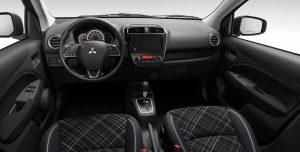
The next-lowest-priced car in the class – Nissan’s Versa – stickers for $15,180 to start and for that you get 27 city, 35 highway. Hyundai ’s Accent sedan matches the Mirage’s mileage, posting 33 city, 41 highway. But to get it, you’ll have to spend $16,645 to start – a difference up front of just shy of $2,000 – which buys a lot of gas, even at $4 per gallon.
Both of these are sedans, by the way – and so only have about a third the available space for cargo.
One of the few other hatches in the class – the Kia Rio – stickers for $17,190 to start and comes only with a CVT automatic. There is also the Chevy Spark – if you hurry. GM has discontinued this model, so the few that are still available are all that ever will be available. Which is a shame, because the Chevy cost less than the Mitsu – $13,600 to start – and is almost as fuel-efficient (29 city/38 highway).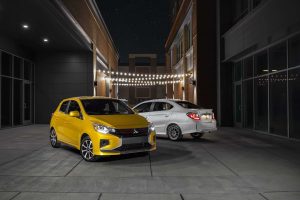
PS: If you prefer a sedan, Mitsu also offers the Mirage that way, too.
What’s New for 2022
Mitsubishi has added a Black Edition to the roster. This one gets black-finished wheels and side mirrors, with red grill accents and matching interior trim.
What’s Good
Spend less on the car, have more money for gas.
Practical hatchback layout provides much more room for cargo than sedans like the Accent and Versa have.
That $14k price isn’t there as a lure to up-sell you into a more expensive trim that has the features that the low-priced-advertised model doesn’t.
What’s Not So Good
Manual transmission is only available with the base ES trim; all other trims come standard with a CVT automatic.
All trims come standard with the same 1.2 liter three cylinder engine, which generates 78 horsepower at 6,000 RPM. This makes it the least powerful engine you can get in a new car – but it also comes in one of the lightest new cars you can get.
The Mirage weighs 2,040 pounds. Which is why this little engine – which is smaller than some motorcycle engines – has enough power to get the Mitsu to 60 in about 10.6 seconds. This is not a speedy time; but it’s not the slowest time, either.
The Mirage is quicker to 60 than a Prius hybrid, for instance. And the standard five speed manual makes it feel quicker than it is (more on that follows, below).
But the main reason people want this car is because it’s easy on gas. It also goes remarkably far on very little gas, an attribute that’s very relevant given how hard electric cars – which don’t go nearly as far – are being pushed.
The Mirage carries 9.2 gallons of gas, fully tanked up. This is enough to take you 377 highway miles and 303 in the city. For reference, EVs like the Nissan Leaf that cost almost twice as much only go about half as far and even the much-touted Tesla Model 3 only goes 272 miles on a charge – unless you spend almost four times as much as a Mirage costs for the “long range” (358 miles) version of that one.
A five speed manual transmission is standard in the ES trim, with the option to swap that out for a continuously variable (CVT) automatic. Equipped with the CVT, the little Mirage delivers the biggest MPG numbers of any new car you can buy that isn’t a hybrid – 36 city, 43 highway.
The Mitsu’s city MPG number is as good as – and on some cases, better than – the highway figures posted by a number of “economy” cars. Its highway number is unsurpassed by anything else that costs as little, which saves you twice.
To put a number on that, consider the savings vs. the Kia Rio – the only other hatchback in the same class now that the Spark has been put out, so to speak. You spend about $2,000 less for the Mitsu – which means you’ve got $2,000 left to buy gas with. That buys about 500 gallons of gas at $4 per gallon. Which amounts to about 55 fill-ups (9.2 gallons each) that will take you in effect didn’t have to pay extra for – by buying the Mitsu rather than the Kia.
Something else to consider in terms of the value proposition here is the absence of a turbocharger. The Mitsu’s engine is very small but it is also relatively simple and could probably be economically replaced, should that ever become necessary. This could prove to be very important in economically depressed times – which could last for a long time.
The Mirage isn’t slow. It’s just not fast. The difference is important.
Slow is an overloaded RV that can’t get up to speed, ever. A school bus with a governor that prevents it from going faster than 60, even on the highway. It is not 10-something seconds to get to 60. That is merely not very quick.
But it’s quick enough.
Sufficient to get up to speed – with enough speed in reserve to maintain 75 on the highway. Perhaps not more than enough – but that would be beside the point, wouldn’t it? The point of the thing being to use the least gas for the least money possible.
This the Mitsu excels at.
Per above, it also feels quicker than it is because it is so small – and so light. How Mitsu managed to keep the curb weight so low given all the government regs that have pushed the curb weight of other cars so high is something of a miracle as well as an admonishment to the rest. If Mitsu can build a just-over-2,000 pound car that complies with all the regs, why can’t the others?
A Rio weighs 2,767 lbs. A Versa, 2,599 lbs. A Spark weighed 2,246 lbs. – before Chevy cancelled it. Remember the old lady from the Burger King commercials? Where’s the beef?
Right over there, pal.
But it isn’t here.
Even though the CVT-equipped versions are the most economical, the manual-equipped ES is the most fun. It also feels the speediest, if that’s the right word. Also – probably – the one least likely to hit you with any expense that might cost you gas money. Manuals rarely break; CVT automatics have a built-in tendency to. The belt/band that allows the CVT to continuously vary contracts and expands over time, fatiguing the metal it’s made of.
Eventually it’ll break and when that happens, you’ll need a new CVT.
You might one day need to put a new clutch in the manual-Mitsu. But that won’t cost you nearly as much gas money and in the meanwhile, you’ll be having a lot more fun. You can make the most of what you’ve got with a clutch and a shifter in a way you can’t with a CVT – or any kind of automatic. You can rev the engine and slip the clutch, to launch in a way more favorable to acceleration. And – inside baseball – if you’re good with a stick you can match or even beat the CVT’s posted mileage numbers without paying extra for the CVT.
That’s fun, too.
On the less fun side of the ledger, the Mitsu’s tiny engine is operating at more than two-thirds of its capabilities at 75 MPH, so there’s little hope of passing anything doing just a few MPH less than that unless you have plenty of time to let the speed build. But this is also fun – in a way that people old enough to remember the fun of driving an old VW Beetle on the highway will remember. Lots of great stories were made that way, back in the day.
Today, you can make your own stories-for-later in a Beetle-like car that has cold AC and a working heater.
At The Curb
Aside from its high mileage and low price, the other appealing attribute of this little hatchback is just that.
It isn’t a sedan, like the Versa and the Accent. This is important – if you like the idea of a small, highly efficient little car that doesn’t cost much but which you’d like to be more than just a commuter car, limited by how much stuff it can carry.
Sedans like the Accent and Versa seat four people, too. Theoretically, five – if you can stuff three in the back. But they each can only take a relative handful of their passengers’ things in their tiny trunks – 13.7 and 14.7 cubic feet, respectively.
Well, relative to the comparatively huge 17.1 cubic foot cargo hold behind the Mitsu’s back seats, which can be increased to 47 cubic feet by lowering the rear seat backs. This endows this tiny car with practical capabilities far beyond those of same-sized sedans such as the Versa and Accent, which are incapable of carrying home the bulky things you can fit inside the Mirage.
Nissan used to offer the Versa in hatchback form, by the way – but no longer does. And Chevy just gave the exit-stage-left to the Spark, which was the only other car in the class that presented a real threat to the Mirage in terms of price, mileage – and capability, being a hatchback, too.
Mitsu could probably save some money – and lower the price even more – by nixing the other trims. The base ES trim has everything a person shopping for a low-cost, basic transpo unit would probably want – and more.
It is astonishing – if you’re old enough to remember cars like the Chevy Chevette or Ford Pinto, before it – to behold the lowest-priced new car available and behold that it comes standard with climate control AC, keyless entry, cruise control, a decent four speaker stereo and a seven-inch LCD screen, too.
Plus a full set of gauges.
Equally astonishing is the fact that you can add leather trim, heated seats, rain sensing wipers and proximity keyless entry (the car unlocks as you approach) and get all that for less than $18k without even trying to haggle it down.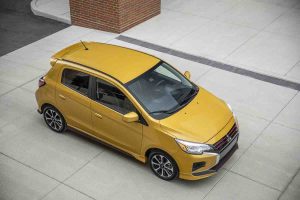
PS: If you don’t want items such as Lane Departure Warning, simply stick with the base ES trim – which doesn’t come standard with it.
The Bottom Line
Why spend $40k on an electric car to deal with the hit of $4 gas when you can spend $25,000 less on a new Mirage?
. . .
Got a question about cars, bikes or anything else? Click on the “ask Eric” link and send ’em in! Or email me at EPeters952@yahoo.com if the @!** “ask Eric” button doesn’t work!
If you like what you’ve found here please consider supporting EPautos.
We depend on you to keep the wheels turning!
Our donate button is here.
If you prefer not to use PayPal, our mailing address is:
EPautos
721 Hummingbird Lane SE
Copper Hill, VA 24079
PS: Get an EPautos magnet or sticker or coaster in return for a $20 or more one-time donation or a $10 or more monthly recurring donation. (Please be sure to tell us you want a magnet or sticker or coaster – and also, provide an address, so we know where to mail the thing!)
My eBook about car buying (new and used) is also available for your favorite price – free! Click here. If that fails, email me at EPeters952@yahoo.com and I will send you a copy directly!




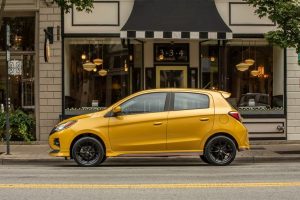
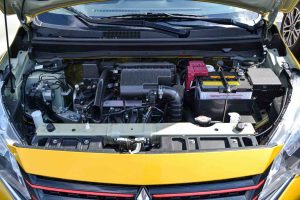

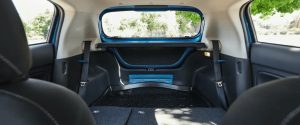
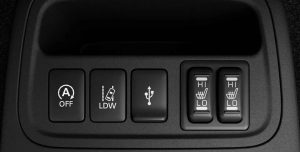







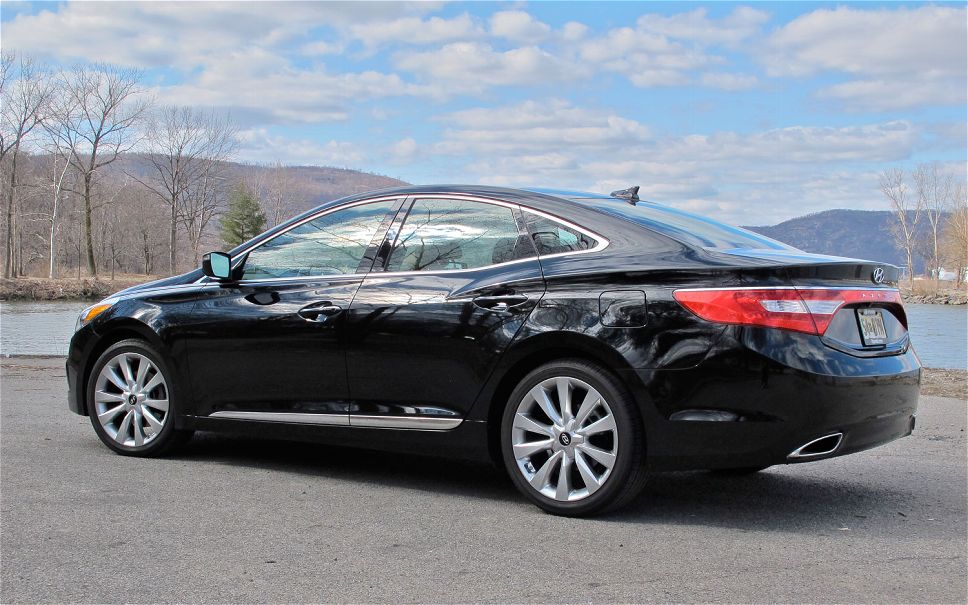
This is what will one day be gone. A cheap car that almost anyone can afford, be it for a primary or to drive to work.
Manual will all the stuff you could want in a sub $15k car.
May not be everyone’s cup of tea, but we have the choice to buy it, or not. That may not be the case for long.
I found this chart on a mirage forum: https://mirageforum.com
MPG vs. MPH
https://mirageforum.com/imgs/graph-speed-mpg-mirage2.jpg
@ 37 mph the mirage gets 70 mpg
Not only can you save $25K buying a Mirage over an EV; that $25K will buy a TON of gas! Even using the lower city number of 33 mpg, that $25K will buy 5,000 gallons of gas; that’s enough to travel 165,000 miles… 🙂
Amen, Mark!
If I didn’t have to have a truck, I’d be getting something like this. Small, light – extremely efficient. As far as “the slows” – well, my truck is that, too. It has never been a problem because timing is everything. That and some skill. I often amuse myself by losing “drivers” who can’t coming up and down Bent Mountain, they in some new “sport sedan” or similar and me in my 20-year-old truck.
I have a 2015 manual. If the current revision remains similar enough (mine is about 100lbs lighter, from memory), then you can easily exceed the EPA fuel economy ratings. (I live in the flat middle of Illinois, so adjust for any terrain, but…) I get about 39mpg in town regularly, and can get over 40 in town at night when the traffic dies off. Interstate, expect anywhere from 38 to 45, depending on traffic speeds and whether or not you run the AC compressor. Rural roads, sustained 45-55mph, 47 to 49mpg is doable. I’ve broken 50mpg on a handful of occasions- not hypermiling, just not wringing it out, either, little or sparse traffic.
My only gripe with it as a practical car is that the paint is pretty thin, so look at a color that will be easy to touch up chips if you’re thinking of one, and for new you may want to preemptively treat/paint for rust this little cavity behind the rear quarter-panel/fender, over the wheel wells- it likes to get some moisture stuck in there after a few years, otherwise.
Excellent car for basic transportation or regular commutes, just don’t expect more from it than it was intended to be.
I believe your mpg numbers. Driving slower than freeway speeds dramatically improves fuel economy as this chart shows for a Geo Metro 1.0 liter 5spd (the Mirage would probably have a similar curve – and it is easy to verify with a OBD2 reader):
https://metrompg.com/zoom_image.htm?H=391&W=519&ZoomFile=mpg%2Dvs%2Dspeed%2Dchart%2Dz%2Egif&Caption=&title=Blackfly%20graph
How about a $500 car that get 50 mpg?
Forget new cars – get a Geo Metro while you still can. Still the best. Extremely reliable – single injector TBI – never had one fail.
These early 1990’s weigh in at 1640-1680 lbs.
And the engine is 998 cc. Weighs 134 lbs.
Also – the car is the easiest car I have ever worked on. You can get most parts on Amazon. I’ve changed timing belts in 30 minutes on the side of the road. Changing the starter takes 20 minutes. The engine is small so it is easy to get the wrenches down in.
What they should do is put the early version of the Metro back into production. As it is dirt cheap to build and no expensive hybrid battery to replace.
Screw new cars. Take a look at this chart just to see how well the US car market is going:
https://fred.stlouisfed.org/series/DAUTOSA
Heading toward zero.
https://www.metrompg.com/
Good stuff, Jack, re the Metro. As you say, a great little car if the object is simplicity and low cost. It’s like owning a motorcycle that keeps you out of the weather and that can carry more stuff!
I haven’t seen one around my neck in years, though…
It amazes me that the highest fuel economy was achieved 30 years ago and now they beat it with expensive hybrid contraptions – which have questionable value after 10 years – when the hybrid battery starts to go. And you need a degree in electrical engineering to work on them.
Like Jay Leno says you can use all of the power all of the time.
2000 lb. is a good weight about the same as the old Mk2 Golfs, the Mk1 Golfs were around 1800 lb., both were available with diesels, 38 mpg city, 55 mpg highway, we have gone backwards.
Another 2000 lb car was the 1980 924 Porsche Carrera GTR, the best handling car ever built, 2.0 lt. turbo, 375 hp. (In trans am tune 550 hp). It was the quickest Porsche sold in 1980.
0 to 60 2.9 sec. 9.95 sec 1/4 mile. 17 were built. All the new supercars/hypercars are 3000 to 4000 lb now, overweight….
you can buy one……
https://www.thedrive.com/news/30473/texas-porsche-dealership-asking-925000-for-1981-porsche-924-carrera-gtr
1980 Le Mans 24 hour race,
Porsche brought a handful of 924 Carrera GTRs to compete in the GTP class in the 1980 Le Mans 24 hour race, with the best car finishing sixth overall
After 24 hours laps completed:
924 Carrera GTR 317
Porsche 935/77A 314
Porsche 935-JLP2 313
Ferrari 512BB/LM 313
BMW M1 294
Porsche 911 SC 281
Lancia Monte Carlo Turbo 273
Porsche 934/5 272
Mazda RX-7 267
Chevron B36 277
Lola T298 273
Porsche 934 249
Dome Zero RL80 247
Chevrolet Corvette and Camaro with 7.0 litre V8’s did not qualify.
In 24 hours the 924 GTR lapped the 911sc 33 times
Trans-Am Sears Point 1985 Sears Point International Raceway
#36 Paul Miller (USA) Porsche 924 GTR Carrera Turbo, in practice set a new lap record 1:34,234 this record wasn’t broken till 1995.
550 hp 2050 pounds, faster then the American 650 hp V8’s it was racing against.
I have never serviced a Mirage that wasn’t a worthless piece of scrap metal, that doubled in value with just an oil change. It’s always been the Festiva of imports. (Something had to fill the void since the French retreated in 1987 after assaulting us with the Alliance, cough cough) It has always been aptly named, being the car “that really isn’t there”. I suspect the “new” Mirage is just trying to look like the 1990’s Honda Civic, which it’s not, lol! Mitsubishi imports have never impressed me, and most often are just a disposable wet-wipe, even when disguised as a slick, sporty Chrysler something-or-other.
That’s exactly what it reminded me of, a 1980’s Honda Civic.
Used to have lots of 70’s-80’s civics, and they were fun, but ya had to keep them wrung out, but that was the fun part.
Not sure if this unit would hold up like a Honda of old, but even if it’s close in reliability it would be worth it. The 70’s-80’s Honda’s weren’t the the best in reliability either though. I was a Honda mechanic and they had their troubles, like all cars of that timeframe.
So the answer on this one, assuming you have a local dealer is run it wild till the warranty runs out and get another one.
It looks to have gobs of space under the hood. Get it with the manual trans and I bet you could keep that little nugget on the road a long time for cheap. On the flipside with a cvt the fun goes right out the window… a used one would make a fine golf cart or tadpole trike with heavy modifications.
I never thought I’d see another practical new car weigh in at 2000 lbs. This is what a Geo Metro would have been today had GM kept its pact with suzuki. I’ve liked these miragemobiles since they were introduced and the styling has finally lost the bubble car look. Hondas going to regret making the Fit fat, then cancelling it. With high gas prices here to stay I expect to see a lot more of these on the road. It’s a shame the presscorps probably sent you the top of the line CVT equipped version. I bet you would have had a blast rowing the gears on those twisty mountain roads. I have a blast in my ’92 5speed geo tracker with the 1.6 and it’s dog slow but she sure does sing through every gear.
Maybe the silver lining to doomsday fuel costs will be a renaissance for light fun cars like all the hatches and coupes of the 80’s to early 90’s… If only somebody would make a new Fiero *sigh*